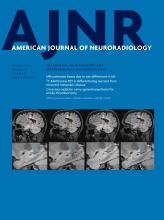Abstract
BACKGROUND AND PURPOSE: In patients with metastatic brain tumors after gamma knife radiosurgery, the superiority of PET using 11C-methionine for differentiating radiation necrosis and recurrent tumors has been accepted. To evaluate the feasibility of MR permeability imaging, it was compared with PET using 11C-methionine, FDG-PET, and DWI for differentiating radiation necrosis from recurrent tumors.
MATERIALS AND METHODS: The study analyzed 18 lesions from 15 patients with metastatic brain tumors who underwent gamma knife radiosurgery. Ten lesions were identified as recurrent tumors by an operation. In MR permeability imaging, the transfer constant between intra- and extravascular extracellular spaces (/minute), extravascular extracellular space, the transfer constant from the extravascular extracellular space to plasma (/minute), the initial area under the signal intensity–time curve, contrast-enhancement ratio, bolus arrival time (seconds), maximum slope of increase (millimole/second), and fractional plasma volume were calculated. ADC was also acquired. On both PET using 11C-methionine and FDG-PET, the ratio of the maximum standard uptake value of the lesion divided by the maximum standard uptake value of the symmetric site in the contralateral cerebral hemisphere was measured (11C-methionine ratio and FDG ratio, respectively). The receiver operating characteristic curve was used for analysis.
RESULTS: The area under the receiver operating characteristic curve for differentiating radiation necrosis from recurrent tumors was the best for the 11C-methionine ratio (0.90) followed by the contrast-enhancement ratio (0.81), maximum slope of increase (millimole/second) (0.80), the initial area under the signal intensity–time curve (0.78), fractional plasma volume (0.76), bolus arrival time (seconds) (0.76), the transfer constant between intra- and extravascular extracellular spaces (/minute) (0.74), extravascular extracellular space (0.68), minimum ADC (0.60), the transfer constant from the extravascular extracellular space to plasma (/minute) (0.55), and the FDG-ratio (0.53). A significant difference in the 11C-methionine ratio (P < .01), contrast-enhancement ratio (P < .01), maximum slope of increase (millimole/second) (P < .05), and the initial area under the signal intensity–time curve (P < .05) was evident between radiation necrosis and recurrent tumor.
CONCLUSIONS: The present study suggests that PET using 11C-methionine may be superior to MR permeability imaging, ADC, and FDG-PET for differentiating radiation necrosis from recurrent tumors after gamma knife radiosurgery for metastatic brain tumors.
ABBREVIATIONS:
- BAT
- bolus arrival time (seconds)
- CER
- contrast-enhancement ratio
- fPV
- fractional plasma volume
- GK
- gamma knife radiosurgery
- IAUGC
- the initial area under the signal intensity–time curve
- Kep
- the transfer constant from the extravascular extracellular space to plasma (/minute)
- Ktrans
- the transfer constant between intra- and extravascular extracellular spaces (/minute)
- MaxSlope
- maximum slope of increase (millimole/second)
- MET
- 11C-methionine
- Ve
- the extravascular extracellular space
- © 2017 by American Journal of Neuroradiology












